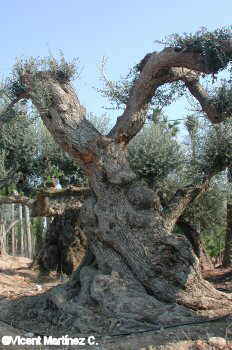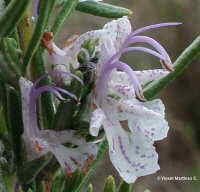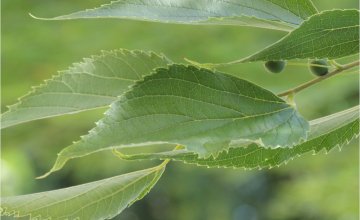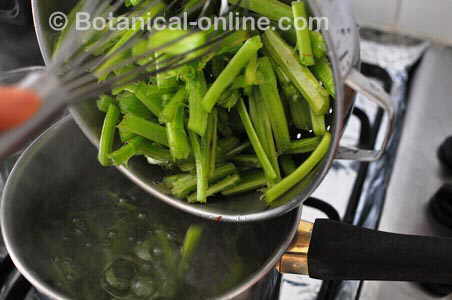Contents
Planting, flowering and fruiting of the olive tree
Plantation:
There are two main methods of planting olive trees:
- Using seedlings produced in a nursery: They can be obtained through two procedures.
- By means of stakes of about 15 cm. After wetting them with products designed to promote root growth, they are planted on a perlite substrate in a warm place. After a month and a half, the rooted specimens can be transplanted in pots.
- Through seeds whose bark has been broken. The seed is wrapped in manure so that it can germinate, which will happen in about 15 to 20 days. After transplanting it, it can be grafted.
Whether one method or another is used, the seedlings already developed in a pot of about 40 or 50 cm of altitude should be chosen. The tallest specimens produce fruits previously but are more expensive to acquire. We can even acquire adult specimens that adapt easily. However, they are very expensive, so they are normally used for gardening and decoration of squares, rather than for the production of olives. The pot will be turned over and, holding the seedling by the trunk, it will be extracted from the pot. Previously, a hole half a meter deep and about 80 cm wide will be made. The tree will be introduced into the hole, filling it with soil that will gradually pack around the trunk. Once planted, it must be watered abundantly. After planting, the annual work required will be limited to cleaning weeds and annual fumigation. The first fruits will appear, depending on the varieties, during the first two or three years of life, although it is considered that they are not really productive until they reach about seven years.

Specimen of adult olive tree ready to be planted as a gardening tree By planting wild rootstocks (wild-olives) that are later grafted: In this case we will use specimens born from olives, either randomly or through seeds in the nursery. The technique is the same as seen above with the nursery grafted seedlings. Unlike the previous model, after two years, we must graft them with the desired variety.
The non-grafted specimen planting method can be used especially to take advantage of isolated trees that have grown randomly or in small plantations. With large plantations it is easier to use nursery species. The tree base trunk from wild trees are more resistant, although they take more years to produce fruit. The grafting, mainly of the veneer-type graft, is carried out as follows: The branch to be grafted is chosen and the lower branches are cut to the place where it will be carried out. We make a horizontal cut and two vertical ones that will come from the ends of the horizontal cut. The bark of the cut fragment is separated and a fragment of the bark of the new species containing two or three buds is introduced, putting it in contact with the interior of the cut. It is squeezed with the bark separated first and the two are brought together, joining them with a raffia ribbon or string, or covering them with a tied plastic bag, even with mud, which is how it was done before. Then, we will make a circular incision around the entire bark of the branch, above the graft, to hinder the passage of the sap towards the old branch and favor the development of the graft. The union will normally take place after 21 days, when we will cut the bark cover of the grafted tree so that the new buds, free of it, can grow. This task will be carried out from May to August. In the month of March of the following year, the original branches that remain behind the grafted area can be pruned. This way of reproducing is safer than if it is done by means of a shield graft, with which only a single bud is applied to the cut.
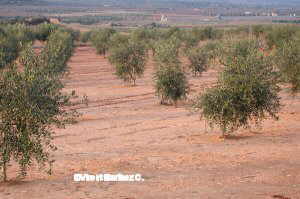
Other methods to reproduce the olive tree are through the layering technique that consists of taking a branch and bending it to bury it in the ground, holding it with a stone. When it produces roots, it can be cut below them and transplanted to its final place.
The planting can be carried out with the following distribution:
- Six meters in square (6×4): It consists of planting the trees in parallel rows, six meters apart. The specimens are also 6 meters apart from each other so that we can consider the field as a series of squares of 6 meters on each side, with a tree located at each of the vertices.
- 6×5: Unlike the previous model, a copy is placed in the center of the diagonals that join the vertices, so that we have the field distributed in six-meter squares with four trees, each one located in one of the vertices and a fifth copy in the center of the other four. As this technique can suppose a distribution that is too tight and not very suitable in less productive lands. It is recommended to extend the sides of the square by one more meter, for which we would have a distribution of 7×5.
In general, we can say that the olive tree has a growing season that is established between 5 and 10 years. Until it reaches 150 years the production is optimal. From this age, olive groves begin to lose productive capacity, although the trees can live for many hundreds of years. There are even millenary specimens, with huge twisted trunks and heavily loaded with wood, but with a very low production.
Flowering, fruiting and collection:
The flowers begin to appear from the end of March. The true flowers appear in the month of April and May, although the most abundant occur in the first month. In June we already have the olives formed, with the size of a pellet. During the summer and autumn the fruits increase in size and turn from green to black. Depending on the species, we can find trees that can be collected from November. The olive harvest normally takes place from November to February. In the past, when they were collected by hand, this lasted until March.
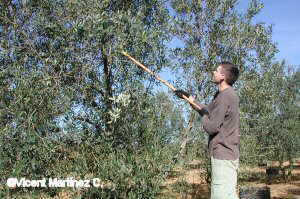 | 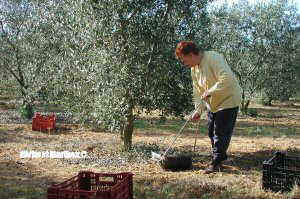 |
Olive tree information
Olive about information
| Benefits of olives | Olive fruit food | Advantages and disadvantages of eating olives |
![]() More information on olive tree
More information on olive tree

